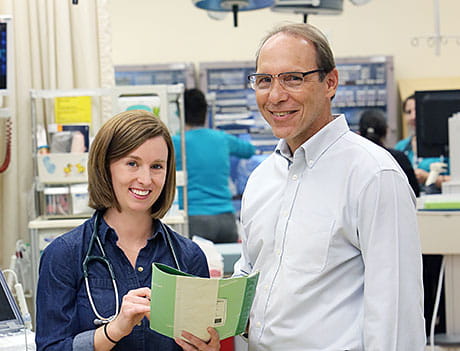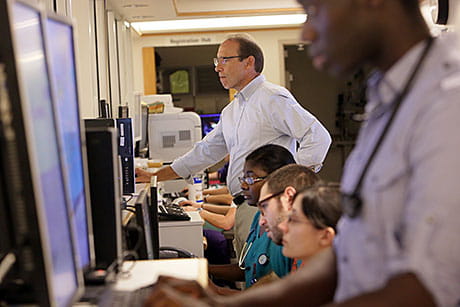Global Exposure

Dr. Erin Hoehn, now a fellow in emergency medicine, with Global Health Residency Track director Dr. Chuck Schubert.
Our Global Health Residency Track Trains Doctors to Care for Children where Resources Are Scarce, Both Overseas and at Home
Erin Hoehn, MD, was a second-year resident when she had her first rotation at the government-run central hospital in Lilongwe, Malawi. Sprawling buildings were connected by outdoor corridors where women hung colorful chitenge cloths, the sort sometimes used as slings to carry babies.
In the muggy heat of the rainy season, oxygen tubing was cleaned and left out to dry for reuse. And in the pediatric zone where Hoehn would spend most of her time, more than 400 sick children – some of them dying – had been squeezed into 300 beds.
“There were patients and families lining the hallways, moms sitting on the floor trying to feed their kids,” Hoehn remembers.
There were only four pediatric trained physicians on staff (it was 2013) for the sad abundance of children with malaria, malnutrition, sepsis, and HIV.
It was a terrifying first day. Hoehn wanted to be helpful, but was worried she wouldn’t be able to handle it. She tried to save the lives of children in a hospital that had extremely limited resources. Children died, too sick to be saved.
Each night, Hoehn and another resident debriefed with Chuck Schubert, MD, who directs the Global Health Residency Track for Cincinnati Children’s. They often did this over dinner with Schubert and his wife, Julie, in the house they all shared in Lilongwe.
“It’s an intense situation,” says Schubert. “In Malawi, when a child dies it’s as much a failure of the whole public health system there as it is the amount of care we can provide them.”
This experience of practicing cross-cultural medicine to care for underserved populations is one had by about 20 Cincinnati Children’s residents each year, in six established sites with strong connections to our faculty and options to rotate through seven other vetted sites.
Residents might rotate in locations like the Hospital Infantil Robert Reid Cabral in the Dominican Republic, where Cincinnati Children’s graduate Rafael Mena, MD, directs the newborn and hospitalist service. Or they might travel to Albert Sabin Hospital in Fortaleza, Brazil, where Cincinnati Children’s gastroenterologist Sean Moore, MD, spends half the year doing research.

Dr. Chuck Schubert hopes Global Health Residency training will encourage doctors to devote their careers to serving underserved populations.
Attracting Top Students
The opportunity to practice medicine in foreign wards is what attracts top candidates like Hoehn to Cincinnati Children’s already competitive residency program.
“Two of our new residents right now have said one of the big reasons they wanted to come here was our great global health program,” says Schubert.
Two rotations in Malawi taught Hoehn to “recognize sick.” It’s where Hoehn, now an emergency medicine fellow at Cincinnati Children’s, chose her specialty. “I enjoyed taking care of the sicker kids,” she says. She also recognized that additional training in emergency medicine would better prepare her for future global health work.
Building Self-Reliance
It also made her a better doctor at home. Just as she did in Malawi, Hoehn sees children with pneumonia, viral syndromes, and influenza. She sees kids severely ill with sepsis. “A lot of those same disease processes are seen here, except here you have more resources to deal with them, and you’re likely catching them earlier,” she says.
Dr. Chuck Schubert hopes Global Health Residency training will encourage doctors to devote their careers to serving underserved populations. Schubert, who himself got “the global health bug” after a year’s work at a rural mission hospital in Zambia, emphasizes to residents that their experience overseas and here in Cincinnati builds skills that transfer to either setting.
“The great majority of them will end up working in the United States,” says Schubert, “but my not-so-private goal or hope is that they’ll continue to be involved with underserved populations.”
Schubert cites a study by the Robert Graham Center reporting that residents who participated in international health tracks were more likely to practice abroad, care for the underserved in the U.S., and have a higher percentage of uninsured and non-English-speaking patients in their practices.
Support throughout the Program
The program begins with a “global health boot camp” for residents that offers a two-week advocacy course and another two weeks providing care at the Gallup Indian Medical Center in New Mexico, which serves members of the Navajo Reservation and the Zuni Nation. When in Cincinnati, residents attend monthly educational meetings, and a journal club encourages shared interests in cross-cultural matters. Residents must also complete scholarly work to graduate with a global health certificate.
When residents return from their overseas experiences, Global Health faculty at Cincinnati Children’s mentor them through their re-entry. Schubert says it’s not uncommon to hear residents compare the number of pediatricians on a single service at Cincinnati Children’s versus the few in an entire hospital overseas.
“It can be difficult to come back,” says Hoehn, “where we have a wealth of doctors and medical professionals and nurses and nutritionists - every resource under the sun” - knowing the needs she left behind.
A Course Set for Life
They are hard lessons, but ones that also inspire. Global health graduate Lisa Ayoub-Rodriguez, MD, returned to her home city of El Paso, Texas, and is developing an immigrant education rotation for residents there.
Under the guidance of Mark Steinhoff, MD, director of the Global Health Center and the Global Health Plus fellowship, another graduate, Amy Rule, MD, is completing a hybrid fellowship in hospital medicine and global health and will work at Tenwek Hospital in Western Kenya for almost a year. She hopes to focus on neonatal care.
Hoehn’s future will balance domestic emergency medicine and trips to far-flung locales that could use the expertise of a highly trained and compassionate pediatrician. As for the hospital she served in Malawi, this September it will have 10 pediatricians, she reports — an increase that still far from meets the need.
 For Ronine Zamor, MD, choosing to travel to Haiti for her Global Health Residency experience had special significance. Zamor’s family is from Haiti. They moved to the U.S. in 1980.
For Ronine Zamor, MD, choosing to travel to Haiti for her Global Health Residency experience had special significance. Zamor’s family is from Haiti. They moved to the U.S. in 1980.




